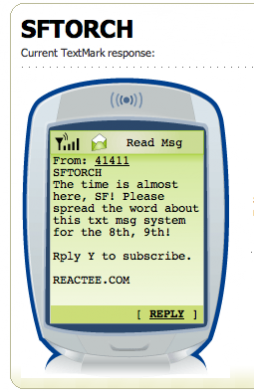An early-morning group text message from SFTorch on txtmarks.com by protest organizers in San Francisco read: "Good morning, what a beautiful day! Default meeting place is Ferry Park, 8 am." Throughout the day, text messages to more than 1,300 people were disseminated by protesters, using Txtmark, a free group messaging system. Thousands of Tibetan exiles and supporters protested the Olympic torch relay throughout the day, forcing the torch route to be changed a number of times.
The Twitter group SFTorch was much smaller with some 200 followers by mid-day and used to report up-to date messages to audiences both in San Francisco and elsewhere. The security prompted messages on Twitter such as this one: "I have never ever seen this much security for an inanimate object" and ""It ain't coming here." --Guy behind me "It's going up and down Van Ness, and nobody is there to see it." --Girl beside me."
Others reported on the scene: "Banners across from ballpark Do you share this Dream? Free Tibet 2008, China you can stop the genocide" and "runners have no idea where they are going, they are being dropped off along route with unlit torches awaiting instructions."
Twitter is a microblogging tool that allows for dissemination of 140-character messages to groups of 'followers' via the web and via text message. Txtmarks -- with its many more users for this event -- was used for coordination with messages such as this: "Stay non-violent and effective" and more logistical messages such as "everyone at Freey Building: Walk South on Embarcadero to join march at Harrison. Be peaceful but come fast!"
In an interview with MobileActive.org, Ariel Poler, CEO of txtmarks.com, said: "Until last night we had no idea what was going on. Suddenly we had 1300 subscribers causing our spam triggers to go off. The organizers notified us and we lifted the spam blocks." He noted that by mid-day in San Francisco, some 15,000 messages had been disseminated.
Txtmarks.com is used by individuals for group text messages, as well as for other civic purposes such bus service alerts, and by religious groups for text messaging youth groups, for example.
A protester and even a reporter streamed live video from their mobile phones, using qik, another free service that allows high-end video mobile phones on a 3G network to stream live video to the Internet. The service also allows for live chat, so we were watching a live stream by a Sacramento Bee reporter while chatting with him on his mobile via the live chat function.
This was the first time that mobile technology was used extensively in the United States to both coordinate and report on a large and important protest, using multiple and free mobile channels.
We at MobileActive.org are, of course, delighted by these developments. We wish the protesters and runners well and hope they stay peaceful and are able to express their views and report them widely using their cell phones.
Other resources on MobileActive.org:
A comparison of Flixwagon and Qik, two services for mobile live streaming
Mobile Phones in Mass Organizing: A MobileActive White Paper


From The SF Organizers -- More on the SF Torch and Text Messagin
This was sent by Nathan Freitas, one of the organizers in San Francisco:
Myself, David Taylor of Radical Designs, and a few other folks ran the txt infrastructure for the Torch protests in San Francisco on Wednesday April 9th. We had 1600 subscribers (out of just a few thousand pro-tibet protesters), in just two days of pre-promotion, running of the Textmarks.com service (http://textmarks.com/sftorch) and Twitter (http://twitter.com/teamtibet). You can view our liveblog page at: http://blog.studentsforafreetibet.org/livesf where we mapped the info we were txting out to a live Google Map.
Here are some great quotes regarding the effectiveness of TXT "power" :)
" Soon after she spoke, cheers erupted among a crowd of Tibetans waiting near Ferry Park as an announcement came — via cell phone text message — that pro-Tibetan activists were "declaring victory" in having turned the hallowed Beijing Olympic torch into a disgraced symbol of China's forced occupation of Tibet." "This is like heaven. Unbelievable," said Tsering Tamding, who moved to Berkeley from a community of exiled Tibetans in South India several months ago. "These people care about human rights. San Francisco has always cared about human rights."
http://www.insidebayarea.com/oaklandtribune/localnews/ci_8875065
"We are reorganizing the protest, sending text messages with minute-by-minute updates on where the torches are," said Tawni Tidwell, a member of protest organizer SF Team Tibet. "People are using their cell phones, BlackBerrys, and PDAs. We are also updating media though our phones, sending pictures."
Tidwell added: "It would be really, really hard if we didn't have this. Can you imagine if the protesters in Lhasa had this technology? Witnesses could just send things in."
http://www.news.com/8301-10784_3-9915609-7.html?tag=nefd.top
Whether the demonstrators' text messaging was an effective tool is tough to determine. After all, if they wanted to know where the torch was, they could have just turned on the television, which was tracking the route live. But the cellphones and text messages did give the protesters a tool on the ground, allowing quick adjustments on their part. All afternoon, as city officials sought to move the torch through the city without confrontation, they were racing too against the speed of mobile messaging.
http://bits.blogs.nytimes.com/2008/04/10/using-tech-to-track-the-torch/?ref=technology
Post new comment